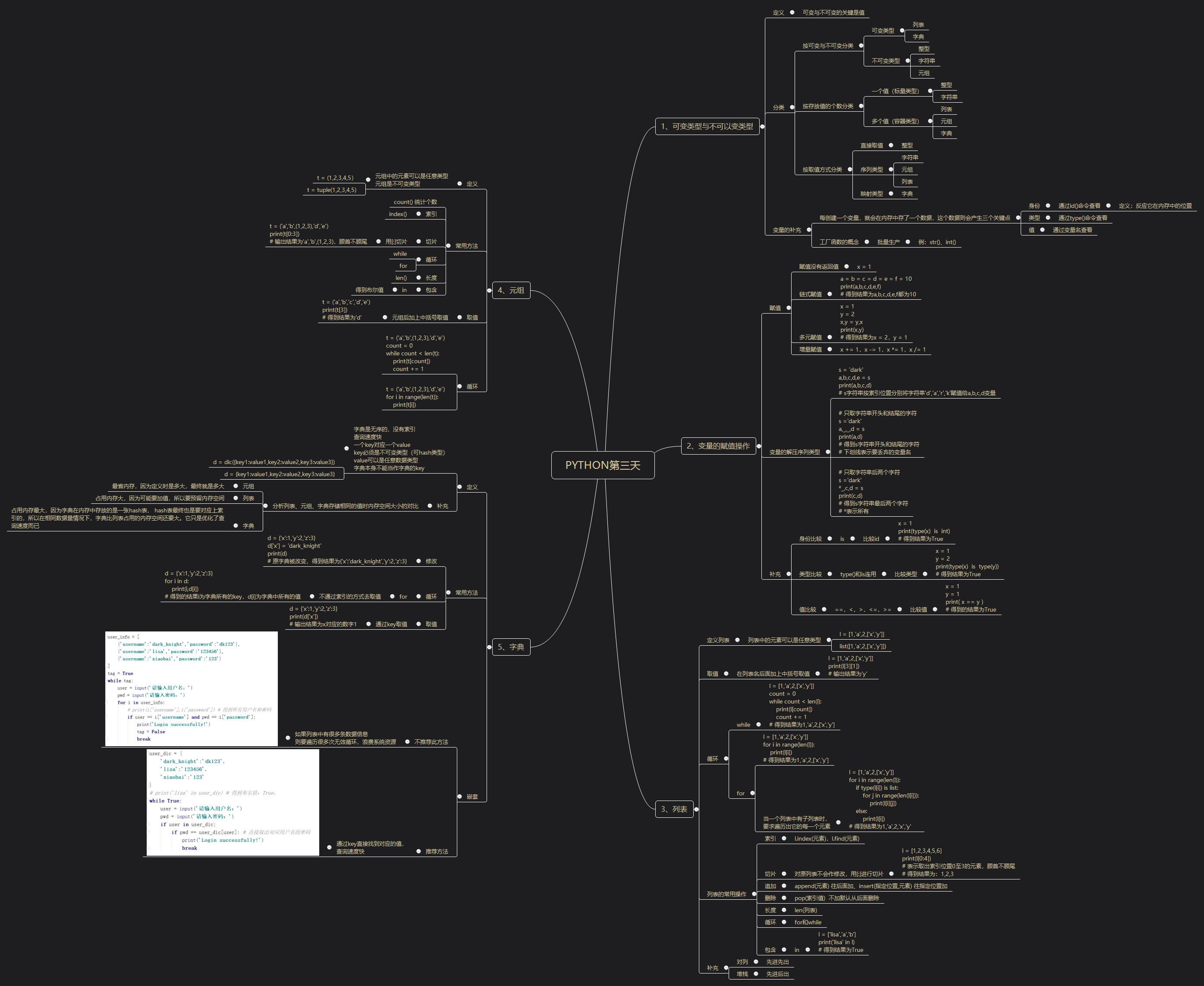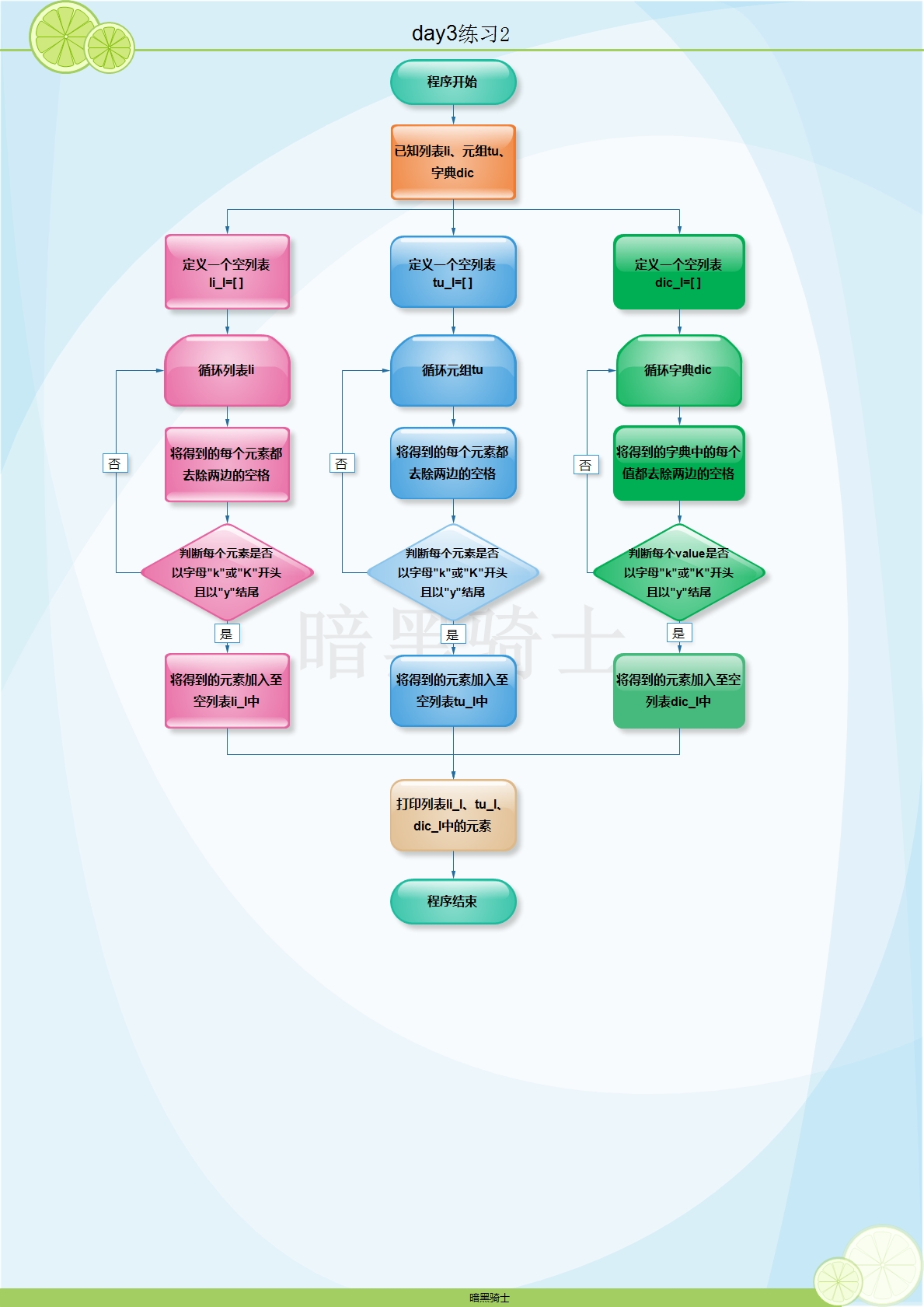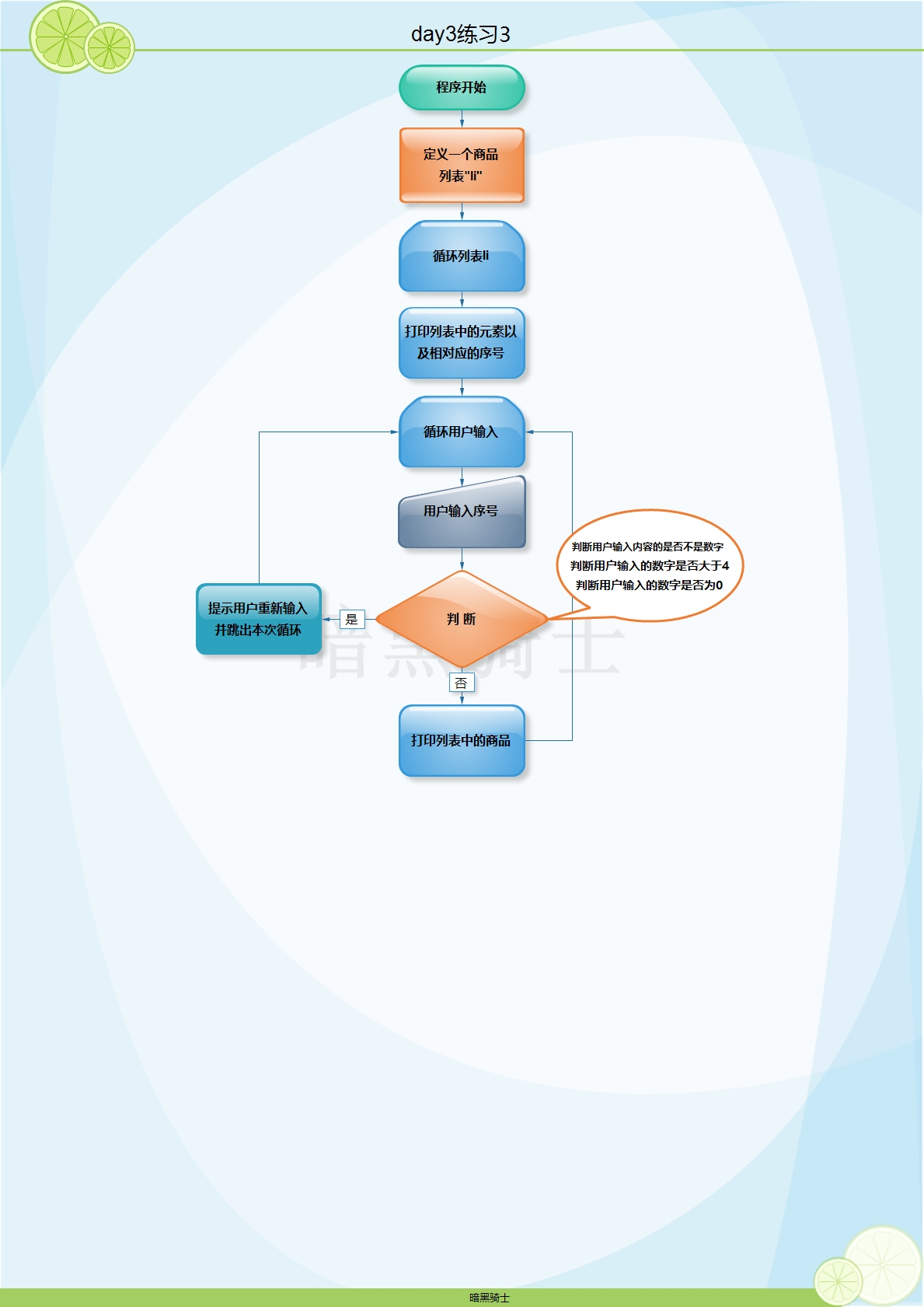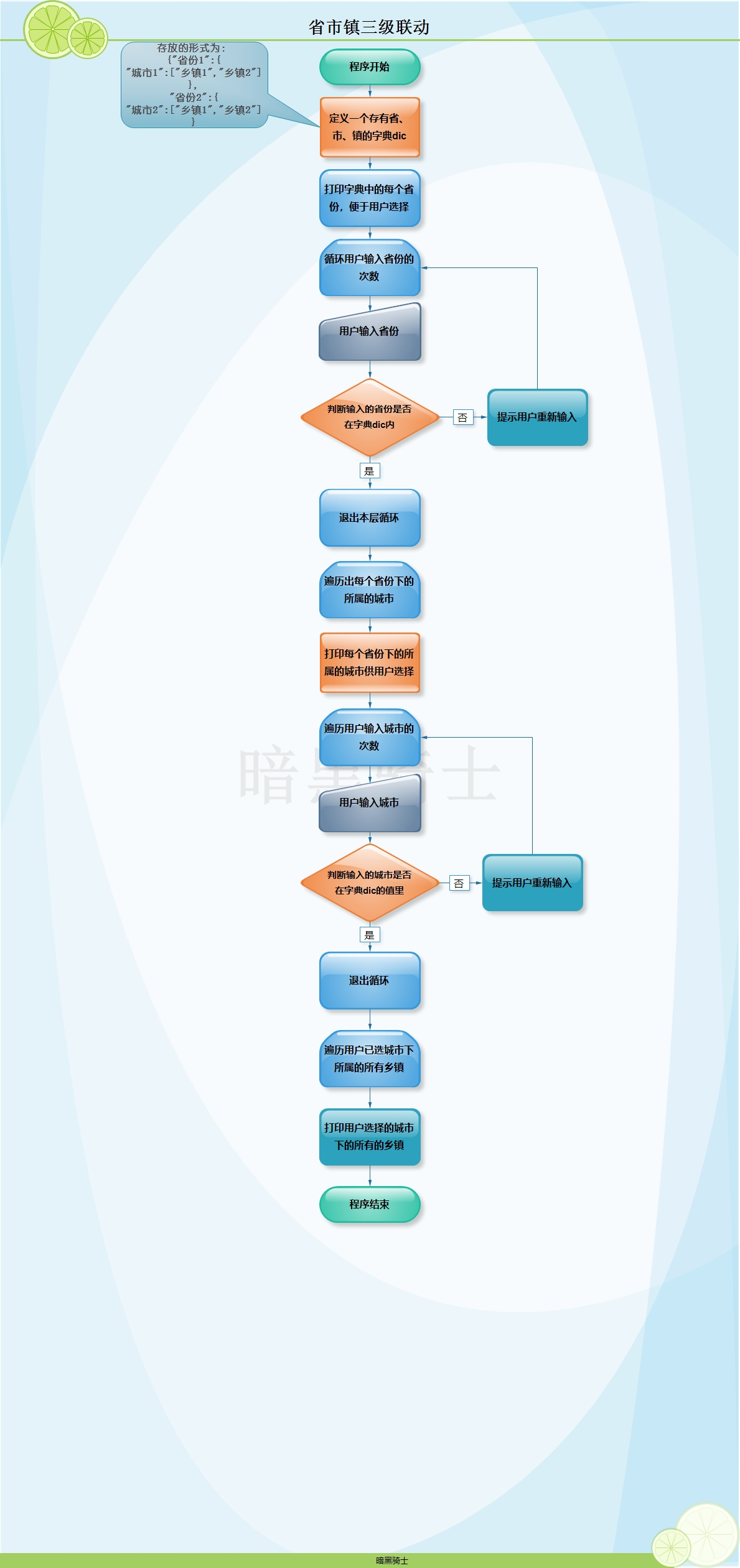Python第三天:可变类型与不可以变类型变量赋值列表元组字典
Posted 暗黑骑士
tags:
篇首语:本文由小常识网(cha138.com)小编为大家整理,主要介绍了Python第三天:可变类型与不可以变类型变量赋值列表元组字典相关的知识,希望对你有一定的参考价值。
一、内容

二、练习
练习1
题目:元素分类
有如下值集合 [11,22,33,44,55,66,77,88,99,90],将所有大于 66 的值保存至字典的第一个key的值中,将小于 66 的值保存至字典的第二个key的值中。
图示:

代码:
l = [11,22,33,44,55,66,77,88,99,90]
d = {\'key1\':[],\'key2\':[]}
for i in l:
if i > 66:
d[\'key1\'].append(i)
else:
d[\'key2\'].append(i)
print(d)
输出结果:

{\'key1\': [77, 88, 99, 90], \'key2\': [11, 22, 33, 44, 55, 66]}
练习2
题目:
查找列表中元素,移除每个元素的空格,并查找以 "k"或"K"开头并且以 "y" 结尾的所有元素。
li = ["kitty", "key", "knight"," Lisa", "sky"]
tu = ("Kitty ", " key", " Knight","Lisa", "xman")
dic = {\'k1\': " knight", \'k2\':\' key\', "k3": "Knight ", "k4": " Lisa"}
图示:

代码:
li = ["kitty", "key", "knight"," Lisa", "sky"]
tu = ("Kitty ", " key", " Knight","Lisa", "xman")
dic = {\'k1\': " knight", \'k2\':\' key\', "k3": "Knight ", "k4": " Lisa"}
li_l = []
tu_l = []
dic_l = []
for i in li:
i = i.strip()
if i.startswith(\'k\' or \'K\') and i.endswith(\'y\'):
li_l.append(i)
for j in tu:
j = j.strip()
# print(j)
if j.startswith(\'k\' or \'K\') and j.endswith(\'y\'):
tu_l.append(j)
for k in dic:
value = (dic[k].strip())
if value.startswith(\'k\' or \'K\') and i.endswith(\'y\'):
dic_l.append(value)
li_l.extend(tu_l)
dic_l.extend(li_l)
print(dic_l)
输出结果:
[\'knight\', \'key\', \'kitty\', \'key\', \'key\']
练习3
题目:输出商品列表,用户输入序号,显示用户选中的商品
li = ["努比亚手机", "小米笔记本", \'iphone X\', \'苹果笔记本\']
说明:
enumerate()内置函数的作用
是python的内置函数
enumerate在字典上是枚举、列举的意思
对于一个可迭代的(iterable)/可遍历的对象(如列表、字符串),enumerate将其组成一个索引序列,利用它可以同时获得索引和值
enumerate多用于在for循环中得到计数
图示:

代码:
li = ["努比亚手机", "小米笔记本", \'iphone X\', \'苹果笔记本\']
for i,v in enumerate(li,1):
print(i,v)
# 其中变量i遍历得到的是序列号
# 其中变量v遍历得到的是列表的每个元素
while True:
user=input(\'请输入序号:\')
if not user.isdigit() or int(user)>4 or int(user)==0:
# 判断用户输入内容的是否不是数字
# 判断用户输入的数字是否大于4
# 判断用户输入的数字是否为0
# 如果满足以上要求则提示用户重新输入,并退出本次循环继续循环
print(\'请重新输入数字\')
continue
print(li[int(user)-1])
# 将用户输入的序号相对应的商品取出来,并打印
注意:
1、列表的索引是从0开始的,而给用户选商品则必须从数字1开始,在使用enumerate()内置函数时,初始的计数就要给数字”1“。
2、isdigit()方法是判断用户输入的内容是否是数字,不包含负数。例如传入一个”-1“时,因为负数占了两个字符了,它会认为是一个”-“和”1“,所以得到的是False
例:
x = input(\'>>:\')
if x.isdigit():
print(\'OK\')
else:
print(\'not ok\')
输出结果:
>>:-1
not ok
3、在打印阶段必须减1,是因数初始计数是从数字1开始的,而列表的取值则是从0开始,所以必须减1
练习4
题目:购物车
功能要求:
用户登陆成功后要求用户输入总资产,例如:20000
显示商品列表,让用户根据序号选择商品,加入购物车
购买,如果商品总额大于总资产,提示账户余额不足,否则,购买成功。
附加:可充值、某商品移除购物车
goods = [
{"name": "努比亚手机", "price": 1499},
{"name": "小米笔记本电脑", "price": 4999},
{"name": "Iphone X", "price": 7999},
{"name": "手机壳", "price": 10},
{"name": "笔记本外壳", "price": 99},
{"name": "苹果笔记本电脑", "price": 11000},
]
代码:
goods = [
{"name": "努比亚手机", "price": 1499},
{"name": "小米笔记本电脑", "price": 4999},
{"name": "Iphone X", "price": 7999},
{"name": "手机壳", "price": 10},
{"name": "笔记本外壳", "price": 99},
{"name": "苹果笔记本电脑", "price": 11000},
]
user = \'knight\'
pwd = \'dk123\'
j = 1 # 将序列从1开始
b = [] # 用于添加序列,用户的购物车
p = {} # 存放序列和价格
n = {} # 存放序列和商品名
tag = True
while tag:
username = input(\'Please enter the username:\').strip()
password = input(\'Please enter the password:\')
if username == user and password == pwd:
print(\'Login successfully!\')
while True:
user_money = input(\'Please enter your funds:\').strip()
if user_money.isdigit():
user_money = int(user_money)
break
else:
print(\'Please try again.\')
print(\'********Product List********\')
for i in goods:
# print(i) # 得到每件商品的字典形式
print(j,i[\'name\'],i[\'price\']) # 打印序列,打印每件商品的商品名,打印每件商品的价格
p[str(j)] = i[\'price\'] # 为字典p添加商品的价格,key为序列,value为商品的价格
n[str(j)] = i[\'name\'] # 为字典n添加商品的名称,key为序列,value为商品名
j += 1
# print(p)
# # 此时打印p字典得到{\'1\': 1499, \'2\': 4999, \'3\': 7999, \'4\': 10, \'5\': 99, \'6\': 11000}
# print(n)
# # 此时打印n字典得到
# # {\'1\': \'努比亚手机\', \'2\': \'小米笔记本电脑\', \'3\': \'Iphone X\', \'4\': \'手机壳\', \'5\': \'笔记本外壳\', \'6\': \'苹果笔记本电脑\'}
print(\'Please select the product code added to your shopping cart(One at a time, press "7" to complete the selection)\')
while tag:
user_select = input(\'Please enter the product code:\').strip()
if not user_select in [\'1\',\'2\',\'3\',\'4\',\'5\',\'6\',\'7\']:
print(\'Please enter the correct product code\')
continue
elif int(user_select) >= 0 and int(user_select) <=6:
b.append(user_select)
continue
elif len(b) == 0:
print(\'The shopping cart is empty\')
continue
elif user_select == \'7\':
while tag:
print(\'This is your shopping list:\')
if b.count(\'1\') != 0:
print(\'name:%s number:%s price:%s\'%(n[\'1\'],b.count(\'1\'),b.count(\'1\')*p[\'1\']))
if b.count(\'2\') != 0:
print(\'name:%s number:%s price:%s\'%(n[\'2\'],b.count(\'2\'),b.count(\'2\')*p[\'2\']))
if b.count(\'3\') != 0:
print(\'name:%s number:%s price:%s\'%(n[\'3\'],b.count(\'3\'),b.count(\'3\')*p[\'3\']))
if b.count(\'4\') != 0:
print(\'name:%s number:%s price:%s\'%(n[\'4\'],b.count(\'4\'),b.count(\'4\')*p[\'4\']))
if b.count(\'5\') != 0:
print(\'name:%s number:%s price:%s\'%(n[\'5\'],b.count(\'5\'),b.count(\'5\')*p[\'5\']))
if b.count(\'6\') != 0:
print(\'name:%s number:%s price:%s\'%(n[\'6\'],b.count(\'6\'),b.count(\'6\')*p[\'6\']))
s = 0
for i in b:
s = s + p[i] # 此时的s为购买商品后的总价格
if s > user_money:
print(\'Sorry, your balance is not enough,still need ¥%s RMB,please select again.\'%(s-int(user_money)))
while tag:
print(\'Press "a" to increase the money\')
print(\'Press "d" to delete the product\')
print(\'Press "q" to quit\')
print(\'Press "r" to resubmit\')
user_select2 = input(\'Please select:\').strip()
if not user_select2 in [\'a\',\'d\',\'q\',\'r\']:
print(\'Please enter again.\')
continue
# 用户充值功能
if user_select2 == \'a\':
while True:
top_up = input(\'Please top-up:\')
if not top_up.isdigit():
print(\'Try again\')
continue
top_up = int(top_up)
break
user_money = user_money + top_up
break
# 删除商品功能
if user_select2 == \'d\':
while True:
print(\'Your shopping list:\')
if b.count(\'1\') != 0 :
print(\'Number:1 Name:%s Quantity:%s Price:%s\' % (n[\'1\'], b.count(\'1\'), b.count(\'1\') * p[\'1\']))
if b.count(\'2\') != 0 :
print(\'Number:1 Name:%s Quantity:%s Price:%s\' % (n[\'2\'], b.count(\'2\'), b.count(\'2\') * p[\'2\']))
if b.count(\'3\') != 0 :
print(\'Number:1 Name:%s Quantity:%s Price:%s\' % (n[\'3\'], b.count(\'3\'), b.count(\'3\') * p[\'3\']))
if b.count(\'4\') != 0 :
print(\'Number:1 Name:%s Quantity:%s Price:%s\' % (n[\'4\'], b.count(\'4\'), b.count(\'4\') * p[\'4\']))
if b.count(\'5\') != 0 :
print(\'Number:1 Name:%s Quantity:%s Price:%s\' % (n[\'5\'], b.count(\'5\'), b.count(\'5\') * p[\'5\']))
if b.count(\'6\') != 0 :
print(\'Number:1 Name:%s Quantity:%s Price:%s\' % (n[\'6\'], b.count(\'6\'), b.count(\'6\') * p[\'6\']))
# 用户输入的钱减去购买商品后的钱。
res1 = int(b.count(\'1\') * p[\'1\'])
res2 = int(b.count(\'2\') * p[\'2\'])
res3 = int(b.count(\'3\') * p[\'3\'])
res4 = int(b.count(\'4\') * p[\'4\'])
res5 = int(b.count(\'5\') * p[\'5\'])
res6 = int(b.count(\'6\') * p[\'6\'])
print(\'Your balance is ¥%s\'%(user_money - res1 -res2 -res3 -res4 -res5 -res6))
while True:
goods_del = input(\'Please enter the code of the product you intend to delete,(Press "7" to end):\').strip()
if not goods_del.isdigit():
print(\'Try again\')
continue
goods_del = int(goods_del)
break
if goods_del == \'7\':
print(\'End delete operation\')
break
elif not goods_del in [\'1\',\'2\',\'3\',\'4\',\'5\',\'6\',\'7\'] or not user_money in b:
print(\'Your shopping cart has no corresponding product!\')
continue
elif goods_del >= 0 and goods_del <= 6:
b.remove(goods_del)
continue
# 重新提交功能
if user_select2 == \'r\':
break
# 退出功能
if user_money == \'q\':
tag = False
tag = False
print(\'Exit the purchase,Your balance is ¥%s\'%user_money)
else:
print(\'The product was successfully added to the shopping cart,Your balance is ¥%s,\'%(user_money - s))
while tag:
user_select3 = input(\'Press "y" to complete the purchase, continue to buy press "n",y/n:\').strip()
if not user_select3 in [\'y\',\'n\']:
print(\'Try again!\')
continue
if user_select3 == \'y\':
tag = False
print(\'End shopping\')
if user_select3 == \'n\':
break
tag = False
else:
print(\'Sorry,the username or password you entered is incorrect,please try again!\')
练习5
题目:实现用户交互,显示省市县三级联动的选择
dic = {
"江西": {
"萍乡": ["安源", "彭高", "上栗"],
"新余": ["良山", "新钢", "兴安岭"],
},
"北京": {
"大兴区": ["礼贤镇", "魏善庄镇", "北臧村镇"],
"昌平区": ["沙河", "化庄", "白浮泉"],
},
"福建": {
"莆田": ["荔城", "西天尾", "九华山"],
"厦门": ["湖里", "思明", "海仓"],
}
}
图示:

代码:
dic = {
"Jiangxi": {
"Pingxiang": ["Anyuan", "Penggao", "Shangli"],
"Xinyu": ["Liangshan", "Xingang", "Xinganling"],
},
"Peking": {
"Daxing": ["Lixian", "Weishanzhuan", "Beizang"],
"Changping": ["Shahe", "Huazhuang", "Baifuquan"],
},
"Fujian": {
"Putian": ["Zhicheng", "Xitianwei", "Jiuhuashan"],
"Xiamen": ["Huli", "Siming", "Haicang"],
}
}
print(\'You can check the following cities information:\\n*****Jiangxi,Peking,Fujian*****\')
# 让用户查询的省份
while True:
province = input(\'Please select the province:\').strip()
if not province in dic:
print(\'Did not find what you want to search, please re-enter\')
continue
break
# 遍历出每个省份中的城市
for i in dic[province]:
print(i,end=\' \')
# 让用户查询城市
while True:
city = input(\'Please select the city:\').strip()
if not city in dic[province]:
print(\'Did not find what you want to search, please re-enter\')
continue
break
# 遍历出每个城市中的乡镇
for j in dic[province][city]:
print(j,end=\' \')
三、英语
1、str 即string的简写
[strɪŋ] n.字符串
2、int 即integer的简写
[\'ɪntɪdʒɚ] 整型
3、list
[lɪst] n.列表
4、tuple
[ˈtjʊpəl; ˈtʌpəl] n.元组
5、dict 即dictionaries的简写
[\'dɪkʃən,ɛriz] n.字典
6、set 即python se的简写t
n.python集合
7、index
[\'ɪndɛks] n.索引
8、find
[faɪnd] vt.查找
9、append
[ə\'pɛnd] vt.附加、添加
10、pop 即popup的简写
v.删除
11、len 即length的简写
n.长度
12、nest
[nɛst] vt.嵌套
13、correct
[kə\'rɛkt] adj.正确的
14、disabled
[dɪs\'ebld] v.失能
15、incorrect
[,ɪnkə\'rɛkt] adj.不正确的
以上是关于Python第三天:可变类型与不可以变类型变量赋值列表元组字典的主要内容,如果未能解决你的问题,请参考以下文章
